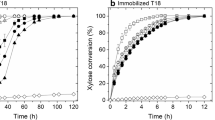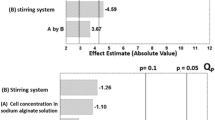Abstract
The present paper studies the biotechnological production of xylitol using sugarcane bagasse hydrolysate in a repeated batch fermentation system with immobilized cells of Candida guilliermondii FTI20037. Immobilized cell system is considered as an attractive alternative to reuse the well-grown and adapted yeast cells in a new fresh fermentation media, without the need of the inoculum stage. In this work, seven repeated batches were performed in a fluidized bed bioreactor using immobilized cells in calcium alginate beads. According to the obtained results it was observed that the immobilized cells of C. guilliermondii can be reused for six successive batches maintaining an average xylitol yield (Y p/s) of 0.7 g/L and a volumetric productivity (Q p) of 0.42 g/L h at the end of 432 h of fermentation. On the other hand, in the seventh batch (504 h), a decrease of 44 % in the final concentration of xylitol was observed. This reduction can be explained by the possible diffusion and accumulation of insoluble substances, found in the hemicellulosic hydrolysate, in the interior of the immobilization support resulting in substrate mass transfer limitations.








Similar content being viewed by others
Abbreviations
- P f :
-
Final xylitol concentration (in gram xylitol per liter)
- P i :
-
Initial xylitol concentration (in gram xylitol per liter)
- Q p :
-
Overall xylitol production rate (in gram xylitol per liter per hour)
- S o :
-
Initial xylose concentration (in gram xylose per liter)
- S f :
-
Final xylose concentration (in gram xylose per liter)
- X rI :
-
Immobilized cell concentration in the reactor (in gram cells per liter)
- Y p/s :
-
Xylitol yield based on xylose consumption (in gram xylitol per gram xylose)
- E :
-
Conversion efficiency of xylose to xylitol (in percent)
- t :
-
Fermentation time (in hour)
- FBR:
-
Fluidized bed reactor
- CV:
-
The coefficient of variation is defined as the ratio of the standard deviation to the mean
- o :
-
Starting value
- p :
-
Xylitol
- s :
-
Xylose
- X :
-
Biomass
References
Milgrom, P., Ly, K. A., Tut, O. K., Mancl, L., Roberts, M. C., Briand, K., et al. (2009). Xylitol pediatric topical oral syrup to prevent dental caries: a double-blind randomized clinical trial of efficacy. Archives of Pediatrics & Adolescent Medicine, 163(7), 601–607.
Ly, K. A., Milgrom, P., & Rothen, M. (2006). Xylitol, sweeteners, and dental caries. Pediatric Dentistry, 28(2), 154–163.
Uhari, M., Kontiokari, T., Koskela, M., & Niemelä, M. (1996). Xylitol chewing gum in prevention of acute otitis media: double blind randomised trial. British Medical Journal, 313, 1180–1184.
Parajó, J. C., Domínguez, H., & Domínguez, J. M. (1998). Biotechnological production of xylitol. Part 3: operation in culture media made from lignocellulose hydrolysates. Bioresource Technology, 66, 25–40.
Santos, J. C., Mussatto, S. I., Converti, A., & Silva, S. S. (2005). Influence of aeration rate and carrier concentration on xylitol production from sugarcane bagasse hydrolysate in immobilized-cell fluidized bed reactor. Process Biochemistry, 40, 113–118.
Cunha, M. A. A., Rodrigues, R. C. B., Santos, J. C., Converti, A., & da Silva, S. S. (2007). Repeated-batch xylitol bioproduction using yeast cells entrapped in polyvinyl alcohol–hydrogel. Current Microbiology, 54, 91–96.
Santos, J. C., Mussatto, S. I., Dragone, G., Converti, A., & Silva, S. S. (2005). Evaluation of porous glass and zeolite as cells carriers for xylitol production from sugarcane bagasse hydrolysate. Biochemical Engineering Journal, 23(1), 1–9.
Carvalho, W., Canilha, L., & Silva, S. S. (2008). Semi-continuous xylose-to-xylitol bioconversion by Ca-alginate entrapped yeast cells in a stirred tank reactor. Bioprocess and Biosystems Engineering, 31, 493–498.
Carvalho, W., Silva, S. S., Vitolo, M., Felipe, M. G. A., & Mancilha, I. M. (2002). Improvement in xylitol production from sugarcane bagasse hydrolysate achieved by the use of a repeated-batch immobilized cell system. Zeitschrift fuer Naturforschung, 57, 109–112.
Champagne, C. P., Blahuta, N., Brion, F., & Gagnon, C. (2000). A vortex-bowl disk atomizer system for the production of alginate fermentor. Biotechnology and Bioengineering, 68, 681–688.
Radmann, E. M., Reinehr, C. O., & Costa, J. A. V. (2007). Optimization of the repeated batch cultivation of microalga Spirulina platensis in open raceway ponds. Aquaculture, 265, 118–126.
Huang, W.-C., Chen, S.-J., & Chen, T.-L. (2008). Production of hyaluronic acid by repeated batch fermentation. Biochemical Engineering Journal, 40, 460–464.
Mussatto, S. I., Rodrigues, L. R., & Teixeira, J. A. (2009). Beta-fructofuranosidase production by repeated batch fermentation with immobilized Aspergillus japonicus. Journal of Industrial Microbiology and Biotechnology, 36, 923–928.
Meleigy, S. A., & Khalaf, M. A. (2009). Biosynthesis of gibberellic acid from milk permeate in repeated batch operation by a mutant Fusarium moniliforme cells immobilized on loofa sponge. Bioresource Technology, 100, 374–379.
Liu, D. W., Zeng, R. J., & Angelidaki, I. (2008). Enrichment and adaptation of extreme-thermophilic (70 °C) hydrogen producing bacteria to organic household solid waste by repeated batch cultivation. International Journal of Hydrogen Energy, 33, 6492–6497.
Yang, X., Wang, B., Cui, F., & Tan, T. (2005). Production of lipase by repeated batch fermentation immobilized Rhizopus arrhizus. Process Biochemistry, 40, 2095–2103.
Carvalho, W., Silverio, S. S., Converti, A., Vitolo, M., Felipe, M. G. A., Roberto, I. C., et al. (2002). Use of immobilized Candida yeast cells for xylitol production from sugarcane bagasse hydrolysate: cell immobilization conditions. Applied Biochemistry and Biotechnology, 98–100, 489–496.
Sarrouh, B. F., dos Santos, D. T., & Silva, S. S. (2007). Biotechnological production of xylitol in a three phase fluidized bed bioreactor with immobilized yeast cells in Ca-alginate beads. Biotechnology Journal, 2, 1–5.
Sarrouh, B. F., & Silva, S. S. (2010). Application of response surface methodology for optimization of xylitol production from lignocellulosic hydrolysate in a fluidized bed reactor. Chemical Engineering and Technology, 33(9), 1–8.
Sene, L., Felipe, M. G. A., Vitolo, M., Silva, S. S., & Mancilha, I. M. (1998). Adaptation and reutilization of Candida guilliermondii cells for xylitol production in bagasse hydrolysate. Journal of Basic Microbiology, 38, 61–69.
Carvalho, W., Silva, S. S., Converti, A., & Vitolo, M. (2002). Metabolic behavior of immobilized Candida guilliermondii cells during batch xylitol production from sugarcane bagasse acid hydrolysate. Biotechnology and Bioengineering, 79(2), 165–169.
Cunha, M. A., Converti, A., Santos, J. C., Ferreira, S. T., & da Silva, S. S. (2009). PVA-hydrogel entrapped Candida guilliermondii for xylitol production from sugarcane hemicellulose hydrolysate. Applied Biochemistry and Biotechnology, 157(3), 527–537.
Silva, D. D. V., Mancilha, I. M., Silva, S. S., & Felipe, M. G. A. (2007). Improvement of biotechnological xylitol production by glucose during cultive of Candida guilliermondii in sugarcane bagasse hydrolysate. Brazilian Archives of Biology and Technology, 50(2), 207–215.
Lima, L. H. A., Felipe, M. G. A., Vitolo, M., & Torres, F. A. G. (2004). Effect of acetic acid present in bagasse hydrolysate on the activities of xylose reductase and xylitol dehydrogenase in Candida guilliermondii. Applied Microbiology and Biotechnology, 65(6), 734–738.
Rodrigues, R. C. L. B., Sene, L., Matos, G. S., Robserto, I. C., Pessoa, J. R. A., & Felipe, M. G. A. (2006). Enhanced xylitol production by recycling of Candida guilliermondii cells in sugarcane bagasse hemicellulosic hydrolysate. Current Microbiology, 53, 53–59.
Felipe, M. G. A., Vieira, D. C., Vitolo, M., Silva, S. S., Roberto, I. C., & Mancilha, I. M. (1995). Effect of acetic acid on xylose fermentation to xylitol by Candida guilliermondii. Journal of Basic Microbiology, 35, 171–177.
Acknowledgments
The authors would like to thank FAPESP for its financial support.
Author information
Authors and Affiliations
Corresponding author
Rights and permissions
About this article
Cite this article
Sarrouh, B., da Silva, S.S. Repeated Batch Cell-Immobilized System for the Biotechnological Production of Xylitol as a Renewable Green Sweetener. Appl Biochem Biotechnol 169, 2101–2110 (2013). https://doi.org/10.1007/s12010-013-0127-0
Received:
Accepted:
Published:
Issue Date:
DOI: https://doi.org/10.1007/s12010-013-0127-0




